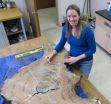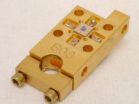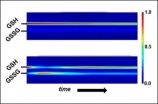(Press-News.org) ANN ARBOR – Poets and physicians know that a scarred heart cannot beat the way it used to, but the science of reprogramming cells offers hope--for the physical heart, at least.
A team of University of Michigan biomedical engineers has turned cells common in scar tissue into colonies of beating heart cells. Their findings could advance the path toward regenerating tissue that's been damaged in a heart attack.
Previous work in direct reprogramming, jumping straight from a cell type involved in scarring to heart muscle cells, has a low success rate. But Andrew Putnam, an associate professor of biomedical engineering and head of the Cell Signaling in Engineered Tissues Lab, thinks he knows at least one of the missing factors for better reprogramming.
"Many reprogramming studies don't consider the environment that the cells are in – they don't consider anything other than the genes," he said. "The environment can dictate the expression of those genes."
To explore how the cells' surroundings might improve the efficiency of reprogramming, Yen Peng Kong, a post-doctoral researcher in the lab, attempted to turn scarring cells, or fibroblasts, into heart muscle cells while growing them in gels of varying stiffness. He and his colleagues compared a soft commercial gel with medium-stiffness fibrin, made of the proteins that link with platelets to form blood clots, and with high-stiffness collagen, made of structural proteins.
The fibroblasts came from mouse embryos. To begin the conversion to heart muscle cells, Kong infected the fibroblasts with a specially designed virus that carried mouse transgenes – genes expressed by stem cells.
Fooled into stem cell behavior, the fibroblasts transformed themselves into stem-cell-like progenitor cells. This transition, which would be skipped in direct reprogramming, encouraged the cells to divide and grow into colonies rather than remaining as lone rangers. The tighter community might have helped to ease the next transition, since naturally developing heart muscle cells are also close with their neighbors.
After seven days, Kong changed the mixture used to feed the cells, adding a protein that encourages the growth of heart tissue. This helped push the cells toward adopting the heart muscle identity. A few days later, some of the colonies were contracting spontaneously, marking themselves out as heart muscle colonies.
The transition was particularly successful in the fibrin and fibrin-collagen mixes, which saw as many as half of the colonies converting to heart muscle.
The team has yet to discover exactly what it is about fibrin that makes it better for supporting heart muscle cell. While most materials either stretch or weaken under strain, fibrin gets harder. Putnam wonders whether the fibrin was successful because heart muscles expect a material that toughens up when they contract.
A number of challenges stand between current techniques and healing hearts by reprogramming scar tissue. Researchers need an effective way to wake up the stem cell properties without the use of potentially risky viruses. Also, the scar tissue needs to be altered so that cell reprogramming – or even new heart cells prepared outside the body – will take well.
INFORMATION:
The paper, titled, "Matrix identity and tractional forces influence indirect cardiac reprogramming" is an open access article in Nature's Scientific Reports in December. http://www.dx.doi.org/10.1038/srep03474 This study was funded by the American Heart Association.
Help for a scarred heart: Scarring cells turned to beating muscle
2014-02-12
ELSE PRESS RELEASES FROM THIS DATE:
San Francisco's big 1906 quake was third of a series on San Andreas Fault
2014-02-12
EUGENE, Ore. -- (Feb. 12, 2014) -- Research led by a University of Oregon doctoral student in California's Santa Cruz Mountains has uncovered geologic evidence that supports historical narratives for two earthquakes in the 68 years prior to San Francisco's devastating 1906 disaster.
The evidence places the two earthquakes, in 1838 and 1890, on the San Andreas Fault, as theorized by many researchers based on written accounts about damage to Spanish-built missions in the Monterey and San Francisco bay areas. These two quakes, as in 1906, were surface-rupturing events, the ...
Clever NIST/JPL technology decodes more information from single photons
2014-02-12
It's not quite Star Trek communications—yet. But long-distance communications in space may be easier now that researchers at the National Institute of Standards and Technology (NIST) and Jet Propulsion Laboratory (JPL) have designed a clever detector array that can extract more information than usual from single particles of light.
Described in a new paper,* the NIST/JPL array-on-a-chip easily identifies the position of the exact detector in a multi-detector system that absorbs an incoming infrared light particle, or photon. That's the norm for digital photography cameras, ...
New NIST method evaluates response to oxidation in live cells
2014-02-12
Researchers at the National Institute of Standards and Technology (NIST) have developed a new method for accurately measuring a key process governing a wide variety of cellular functions that may become the basis for a "health checkup" for living cells.
The NIST technique measures changes in a living cell's internal redox (reduction-oxidation) potential, a chemistry concept that expresses the favorability of reactions in which molecules or atoms either gain or lose electrons. Redox reactions are important to cell chemistry because they regulate many genes and the proteins ...
Popular disinfectants do not kill HPV
2014-02-12
Commonly used disinfectants do not kill human papillomavirus (HPV) that makes possible non-sexual transmission of the virus, thus creating a need for hospital policy changes, according to researchers from Penn State College of Medicine and Brigham Young University.
"Because it is difficult to produce infectious HPV particles for research, little has been known about HPV susceptibility to disinfection," said Craig Meyers, Distinguished Professor of Microbiology and Immunology, Penn State College of Medicine.
Use of disinfectants on HPV in health care settings has been ...
Hollywood failing to keep up with rapidly increasing diversity, UCLA study warns
2014-02-12
When it comes to influential positions in the entertainment industry, minorities and women are represented at rates far below what would be expected given their percentage of the general population, according to a new study done at UCLA's Ralph J. Bunche Center for African American Studies.
In fact, the report shows, the proportion of female and minority actors, writers, directors and producers in films and TV ranges from just one-twelfth to one-half of their actual population percentage.
"The report paints a picture of an industry that is woefully out of ...
Meeting the eye-witnesses of ocean change
2014-02-12
Members of the German research network BIOACID (Biological Impacts of Ocean Acidification) are developing a model that links ecosystem changes triggered by ocean acidification and climate change with their economic and societal consequences. Workshops and interviews with stakeholders from the Norwegian fishing industry and tourism sector, the government and environmental organisations help them to identify key aspects for their assessment.
During the past ten years, scientists have learned a lot about the effects of ocean acidification on marine ecosystems. It has become ...
Cities support more native biodiversity than previously thought
2014-02-12
(Santa Barbara, Calif.) — The rapid conversion of natural lands to cement-dominated urban centers is causing great losses in biodiversity. Yet, according to a new study involving 147 cities worldwide, surprisingly high numbers of plant and animal species persist and even flourish in urban environments — to the tune of hundreds of bird species and thousands of plant species in a single city.
Contrary to conventional wisdom that cities are a wasteland for biodiversity, the study found that while a few species — such as pigeons and annual meadow grass — are shared across ...
4 years on, ICU Patients with kidney injury show high mortality & elevated urinary protein
2014-02-12
In 4 years of follow up of 1464 participants in the randomized controlled trial Randomised Evaluation of Normal vs. Augmented Levels of RRT (RENAL) study, Martin Gallagher (The George Institute for Global Health, Sydney, Australia) and colleagues found that patients with acute kidney injury (AKI) in an intensive care unit (ICU) who require renal replacement therapy (RRT; hemodialysis combined with hemofiltration) do not benefit from higher intensity RRT. At a median of 43.9 months follow up, mortality (63% in the low intensity and 63% in the high intensity group), as well ...
Study challenges a close link between recent weight gain and diabetes
2014-02-12
It is a common notion that type 2 diabetes is precipitated by substantial progressive weight gain, but a study published this week in PLOS Medicine suggests that this might not be true.
Dorte Vistisen and Kristine Færch, from the Steno Diabetes Center in Gentofte, Denmark, and colleagues analyzed data from participants of the Whitehall II cohort, a group of London-based civil servants who have been followed for more than a decade, to see what changes in body weight and other parameters had occurred in people in the years before they were diagnosed with diabetes.
6,705 ...
What makes memories last?
2014-02-12
Prions can be notoriously destructive, spurring proteins to misfold and interfere with cellular function as they spread without control. New research, publishingin the open access journal PLOS Biology on February 11 2014, from scientists at the Stowers Institute for Medical Research reveals that certain prion-like proteins, however, can be precisely controlled so that they are generated only in a specific time and place. These prion-like proteins are not involved in disease processes; rather, they are essential for creating and maintaining long-term memories.
"This protein ...



